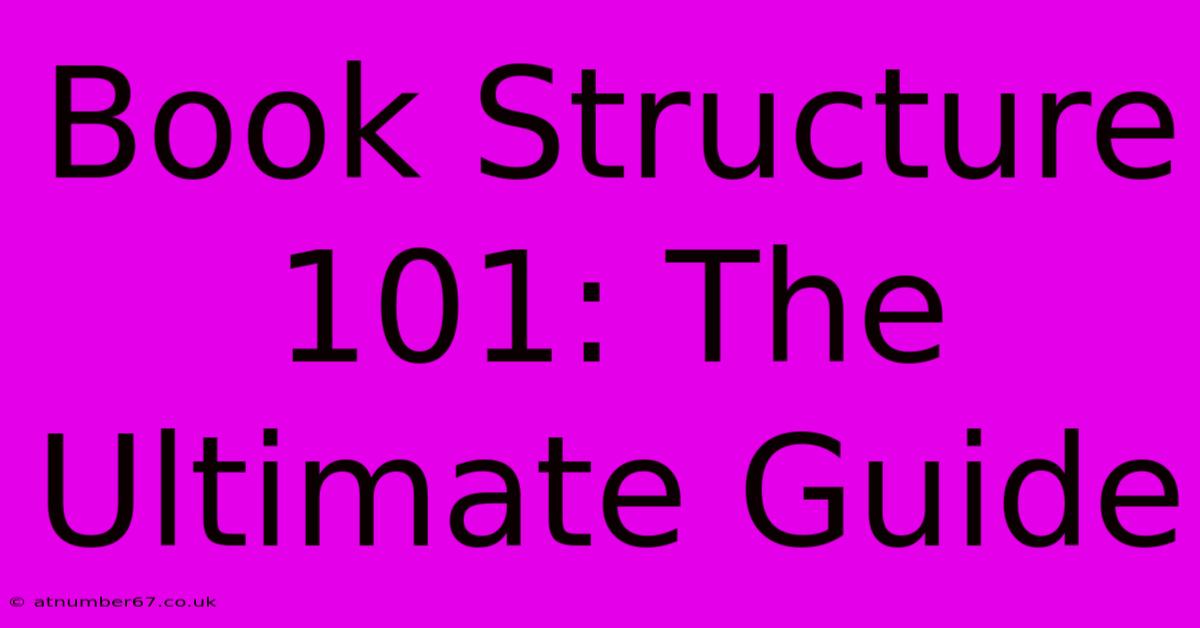Book Structure 101: The Ultimate Guide

Table of Contents
Book Structure 101: The Ultimate Guide
So you've got a fantastic story brewing in your head, a world brimming with characters and conflict. But before you can share your masterpiece with the world, you need a solid foundation: a well-structured book. This guide will walk you through the essential elements of book structure, helping you craft a compelling narrative that keeps readers hooked from beginning to end.
Understanding the Core Elements of Book Structure
A well-structured book isn't just about chronological events; it's about crafting a reader experience. Several key elements work together to create a compelling narrative arc:
1. The Plot: The Engine of Your Story
Your plot is the backbone of your book, the sequence of events that drives the narrative forward. It should include:
- Inciting Incident: The event that kicks off the main conflict and sets your protagonist on their journey.
- Rising Action: A series of events that build suspense and tension, escalating the conflict.
- Climax: The point of highest tension, where the protagonist confronts the main conflict directly.
- Falling Action: The events following the climax, where the consequences of the protagonist's actions unfold.
- Resolution: The conclusion of the story, where loose ends are tied up and the conflict is resolved (or not!).
Pro Tip: Don't be afraid to experiment with your plot structure. Nonlinear narratives, flashbacks, and other techniques can add depth and complexity to your story.
2. Character Development: Breathing Life into Your Cast
Compelling characters are crucial to a successful book. Consider:
- Protagonist: Your main character, the one the reader will root for (even if they're flawed!).
- Antagonist: The character or force that opposes the protagonist.
- Supporting Characters: Characters who enrich the story and provide conflict, support, or obstacles for the protagonist.
- Character Arcs: How your characters change and grow throughout the story.
Pro Tip: Give your characters depth and complexity. Explore their motivations, flaws, and desires. Make them relatable and believable.
3. Setting: Creating an Immersive World
The setting is more than just a backdrop; it's an integral part of your story. A well-developed setting can:
- Enhance the Atmosphere: Create mood and tone, impacting the reader's experience.
- Drive the Plot: The setting can present challenges, opportunities, or even act as a character itself.
- Develop Characters: The setting can reveal aspects of your characters' personalities and backgrounds.
Pro Tip: Use vivid sensory details to bring your setting to life. Engage all five senses to create an immersive experience for your reader.
4. Theme: Exploring Underlying Ideas
The theme is the underlying message or idea your book explores. It's what your story is really about. A strong theme adds depth and meaning to your narrative. Consider questions like:
- What are the central conflicts in your story?
- What lessons are learned by your characters?
- What message do you want your readers to take away?
Pro Tip: Avoid being overly didactic. Let the theme emerge organically from your story, rather than explicitly stating it.
Different Book Structures: Exploring Your Options
While the elements above are fundamental, the way you arrange them can vary. Consider these common structures:
- Linear Structure: The story unfolds chronologically, from beginning to end.
- Nonlinear Structure: The story jumps back and forth in time, using flashbacks or other techniques.
- In Media Res: The story begins in the middle of the action, then fills in the background later.
- Episodic Structure: The story is composed of a series of self-contained episodes, each with its own mini-plot.
Structuring Your Manuscript: Practical Tips
- Outline: Create a detailed outline before you start writing. This will help you stay organized and ensure a cohesive narrative.
- Chapter Breaks: Use chapter breaks strategically to create pacing and tension.
- Scene Transitions: Use clear and concise transitions to smoothly move between scenes.
- Revisions: Be prepared to revise your manuscript multiple times. Seek feedback from beta readers or editors.
Mastering book structure is a journey, not a destination. By understanding these core elements and experimenting with different techniques, you can craft a captivating story that resonates with your readers. Remember, the best structure is the one that best serves your story and its unique narrative.

Thank you for visiting our website wich cover about Book Structure 101: The Ultimate Guide. We hope the information provided has been useful to you. Feel free to contact us if you have any questions or need further assistance. See you next time and dont miss to bookmark.
Featured Posts
-
Elon Musks Net Worth The Numbers Explained
Apr 04, 2025
-
Fuerza Y Honor Son Su Vestidura Mastering Your Destiny
Apr 04, 2025
-
Cocoa Tea Daughter Fuel Your Day The Healthy Way
Apr 04, 2025
-
Stephen Cloobecks Net Worth Bigger Than You Think
Apr 04, 2025
-
The Future Is Now Andy Reids Son Takes The Helm
Apr 04, 2025
